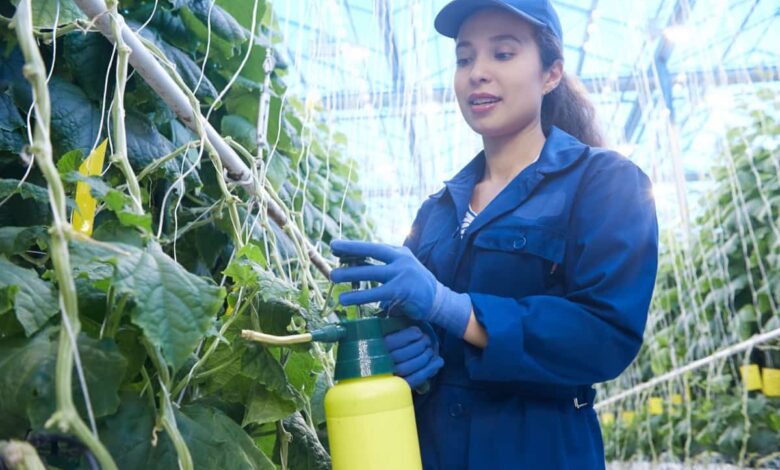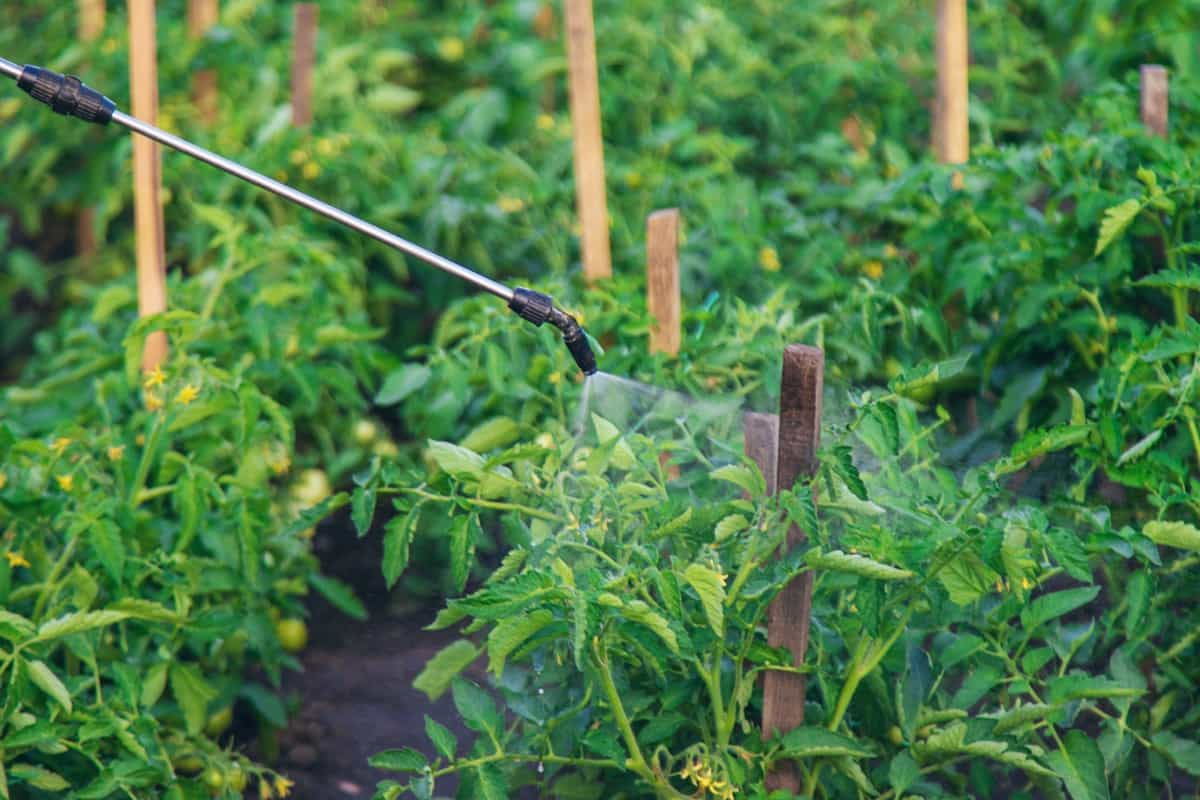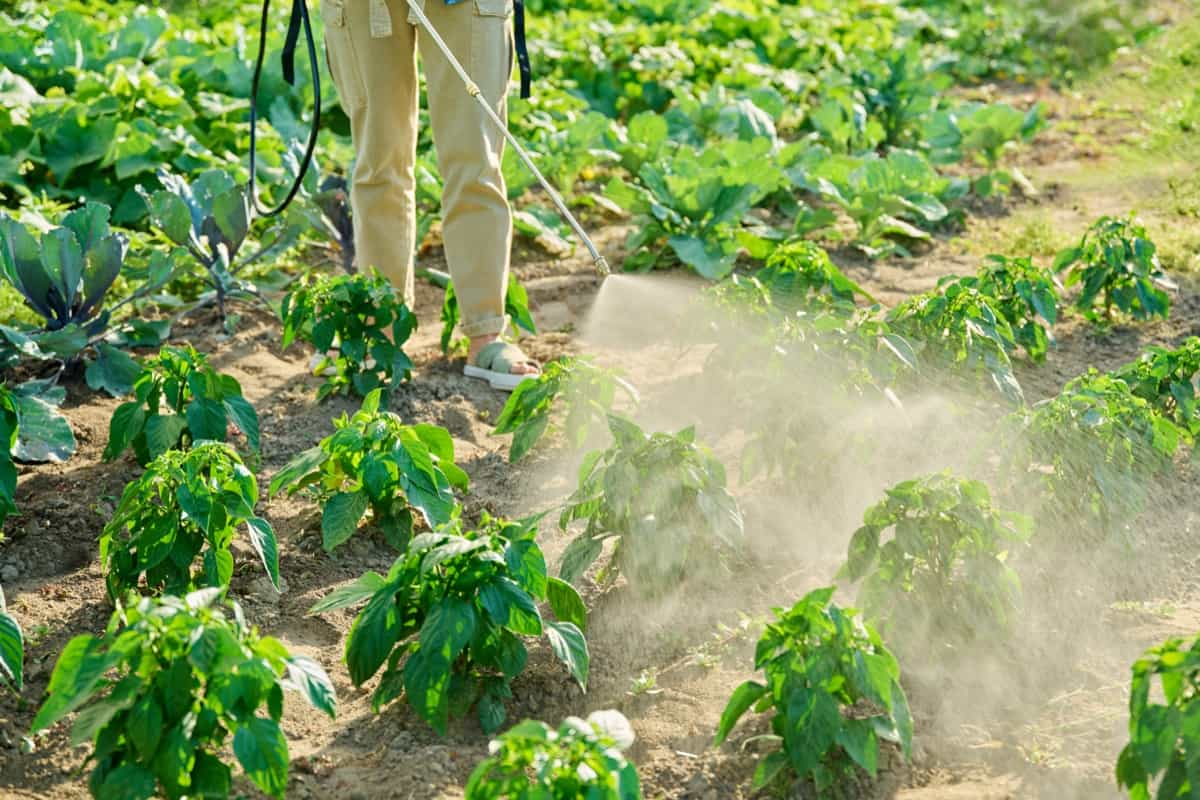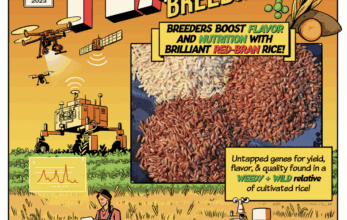How to Make Homemade Pesticides: 15 DIY Natural and Organic Recipes for Garden Plants

Hello gardners, We are back with great information on how to make homemade pesticides with 15 DIY natural and organic recipes for garden plants. For organic farming to be successful, environmentally friendly methods of pest and disease control are crucial. Gardeners can keep their flower gardens, vegetable patches, and houseplants healthy without resorting to harmful synthetic chemicals by making their own insecticides. Make your own natural insecticide at home with these simple ingredients: garlic, neem oil, and essential oils. Use them to protect your plants and the environment. By utilizing organic pest control methods, gardeners promote soil life and biodiversity. Organic garlic spray and DIY neem oil insecticide both use natural properties to ward off pests like spider mites and aphids, which in turn protect pollinators.
The allure of organic pest control lies in its affordability and accessibility. Since vinegar, detergent, and chili peppers are common kitchen staples, these recipes are affordable. For instance, you can make your own chili pepper pesticide or a natural Castile soap pesticide that will effectively control pests for a low budget. These methods ensure that homegrown product is devoid of toxic residues by carefully managing what touches the plants. This realistic approach fosters a deeper connection with gardening and provides individuals with the tools to sustainably maintain their green areas, all while minimizing costs and optimizing results.
This article takes a look at fifteen different all-natural pesticide recipes that you can make at home and see which ones work best for which plants and pests. Whether you’re dealing with fungus or weeds, each solution uses safe, natural ingredients. For example, you can make your own baking soda spray. Each section provides comprehensive instructions, suggestions for application, and plant-specific advice, making it suitable for gardeners of all skill levels. These all-natural insect repellents are simple for anybody to use, and they will help keep plants healthy while also promoting eco-friendly practices. Try these all-natural methods to transform your gardening skills and keep your plants healthy and pest-free.
Protect Your Plants the Natural Way with 15 Easy Homemade Pesticides
A Do-It-Yourself Guide to Neem Oil Pesticides
Orchids, peace lilies, and pothos are among the plants that respond positively to homemade neem oil pesticide, the active component of which is neem oil, an extract from the neem tree. Some of the insects that it targets and hinders their feeding and reproduction abilities are whiteflies, spider mites, and aphids. Add half a teaspoon of natural Castile soap and one teaspoon of pure neem oil to a quart of warm water. The soap emulsifies the oil, resulting in a consistent dispersion. Gently whisk the ingredients in a spray bottle to combine. This pesticide mixture of neem and soap protects delicate foliage without clogging pores, making it ideal for use with indoor and outdoor plants alike.
Be careful not to oversaturate fragile plants like ferns with the do-it-yourself pesticide made of neem and soap. The undersides of leaves are a typical hiding area for bugs; misting them in the morning or late at night will help prevent burn. Begin with a small leaf because certain plants may respond. After seven to ten days, use the pesticide to keep spider mites and other herb pests at bay. Furthermore, this remedy prevents the growth of fungus, which helps plants stay healthy. Be sure to shake your plants before each use and store them in a cold, dark place to ensure they remain protected at all times.

This organic pest control spray is perfect for households with children and pets because it leaves nothing toxic behind. Combine with organic peppermint and garlic spray or neem and garlic spray for all-encompassing bug control. Indoor plants, such as basil or snake plants, can be an effective insect deterrent. You may be sure that the results will last because the oil insecticide and natural dish soap work together to increase adhesion. Gardeners can keep their gardens looking lush and green while using this pesticide, which grows naturally.
| Ingredients | Quantity | Purpose |
|---|---|---|
| Neem oil | 1 tsp | Active pest-repelling component |
| Natural castile soap | 0.5 tsp | Emulsifies oil |
| Warm water | 1 quart | Base for dispersion |
Mixing an Organic Garlic Spray Fertilizer
Because garlic contains sulfur compounds, an organic garlic spray can effectively repel pests from backyard gardens, protecting plants such as tomatoes, lettuce, and cabbage. Blend five garlic cloves with one pint of water after adding a drop of natural dish soap for adhesion and straining through cheesecloth. Put the contents into a spray bottle for handy use. This all-natural garlic spray will keep pests like beetles, caterpillars, and aphids at bay without harming beneficial insects like ladybugs. Applying it once weekly will keep pests away from crops and provide a safe harvest from the garden.
Apply the garlic and chili pesticide mixture first thing in the morning and wait for it to dry before the evening dew to avoid fungal issues. Especially on young, vulnerable plant parts like kale or broccoli, or on the undersides of leaves, be wary of pests. Do not spray too heavily so as not to accumulate moisture. This do-it-yourself organic insecticide leaves no harmful residues behind, and you can safely eat the crops after using it. To make a DIY pesticide using chili peppers more effective against spider mites on herbs, add the following ingredients. You can store it in the fridge for up to a week after shaking it well before use.
Plants like zucchini and spinach benefit from this all-natural insect repellent solution, which also makes your garden more hardy. Its organic nature ensures soil health and pollinator safety. Make your own peppermint and garlic spray or an organic neem and garlic spray to ward against tougher pests. With this garlic and vinegar pesticide, gardeners can protect their harvests in a sustainable way and make their gardens healthy and pest-free without harming the environment.
| Ingredients | Quantity | Purpose |
|---|---|---|
| Garlic cloves | 5 | Sulfur compounds repel pests |
| Natural dish soap | 1 drop | Enhances adhesion |
| Water | 1 pint | Base for blending |
Creating a Homemade Chili Pepper Pesticide
A pesticide created from chili peppers is ideal for protecting plants of eggplants, peppers, and tomatoes, and it’s simple to make at home. Combine two tablespoons of dry chili flakes with one quart of water and set aside to drain. Put a teaspoon of all-natural dish soap in the spray to make it stick better. This organic garlic and chili spray will keep pests like aphids and spider mites at bay. Be careful not to drown the plant to avoid stressing it out, but rather to cover the leaves completely, giving special attention to pest hotspots.
First thing in the morning is the best time to apply this all-natural DIY pesticide so it has plenty of time to dry. It is recommended to do a small-area test on plants, like bell peppers, to ensure that there are no adverse effects. Reapply every five to seven days for persistent pests, including spider mites on herbs. For maximum effectiveness, combine the homemade cayenne pepper spray with a garlic and chili pesticide mixture. Shake the mixture well before use and store it in a cool place to maintain its effectiveness as a garden pest prevention method.
Natural pest repellent made with this recipe is cheap, won’t hurt crops, and won’t leave any dangerous residues. If you want to protect your eggplants from pests or your tomatoes from organic neem and chili, mix it with your homemade chili and oil insecticide. Its fiery disposition deters pests while maintaining beneficial insects, making it a mainstay for organic gardeners. Making this pesticide will help spread eco-friendly gardening practices and ensure that plants thrive.
| Ingredients | Quantity | Purpose |
|---|---|---|
| Dry chili flakes | 2 tbsp | Repels pests |
| Natural dish soap | 1 tsp | Enhances adhesion |
| Water | 1 quart | Base for mixing |
Make Your Own Essential Oil-Based Insect Repellent
Using peppermint and lavender essential oils, among others, can be an effective do-it-yourself bug repellent for flower beds that include marigolds, petunias, and roses. Make a mixture of one teaspoon of natural Castile soap, five drops each of lavender and peppermint oils, and one quart of water. Press firmly on the top of a spray bottle. Lavender oil is a powerful organic insect repellent that keeps pests like beetles, ants, and aphids away from flower beds without using harmful chemicals.
To keep the leaves from being burned and the delicate petals from being overpowered, spray the natural insect repellent solution gently in the evening. Focus on areas that are prone to pests, like the stems of marigolds or the buds of roses. Reapply weekly or after rain for effective protection. This homemade peppermint and garlic spray effectively covers a larger area when combined with an organic pest control spray that includes sage oil. The oils will maintain their effectiveness in your garden for a long time if you store them in a cold, dark place to preserve their potency.
This all-natural DIY insect repellent is ideal for gardens on balconies or patios, and it won’t harm pollinators either. For further protection, apply to houseplants like geraniums. When applied in conjunction with an all-natural insect repellent, lemongrass oil amps up its repelling power. By developing this solution, gardeners can maintain stunning floral displays while embracing eco-friendly practices, ensuring that blooms thrive naturally, unaffected by pests.
| Ingredients | Quantity | Purpose |
|---|---|---|
| Peppermint oil | 5 drops | Repels pests |
| Lavender oil | 5 drops | Repels pests |
| Natural castile soap | 1 tsp | Emulsifies oils |
| Water | 1 quart | Base for mixing |
Making a Non-Toxic Spray for Pest Control
You can easily control aphids on roses, kale, and cabbage with an all-natural soap spray insecticide. Mix one quart of water with one spoonful of natural Castile soap in a spray bottle. Shake gently to integrate without creating excessive foam. This homemade soap and vinegar pesticide is an effective and safe option for organic farming. It dissolves the outer layers of pests like aphids and suffocates them. Plus, it doesn’t harm plants or beneficial insects.
This all-natural DIY pesticide is perfect for getting rid of aphids that have settled on your lettuce leaves or rose stems. Use a morning application to give the leaves time to dry and prevent fungal growth or burns. Apply a small area test first and then reapply every five days if the infestation is severe. Use in conjunction with an organic neem and soap pesticide or a spray composed of rosemary for enhanced pest control. Shake well before use and keep it in a cold place to ensure soap solution distribution.

This natural pesticide is safe for use in home gardens without worrying about harming edible plants or pollinators. To effectively manage aphids, apply to cabbage or spinach plants. For its simplicity and effectiveness, it is a go-to for beginners. This all-natural pesticide made from dish soap and oil is a wonderful option for eco-conscious gardeners looking for a means to keep pests at bay while simultaneously encouraging healthy plant growth.
| Ingredients | Quantity | Purpose |
|---|---|---|
| Natural castile soap | 1 tbsp | Dissolves pest outer layers |
| Water | 1 quart | Base for mixing |
Making a Natural Pesticide from Vinegar
Because of its acidity, organic vinegar pesticide easily eradicates weeds from lawns, gardens, and pathways. It won’t harm strawberries or tomatoes if applied nearby. The recipe calls for three parts water, one part apple cider vinegar, and a teaspoon of natural dish soap for adhesion. Pour into a spray bottle and apply right away to weeds; do not apply to desired plants. Instead of using harmful chemicals, organic gardeners can use this vinegar pesticide recipe that disrupts the cellular structure of weeds.
Applying the DIY organic pest control spray on a sunny day will maximize its potency, as heat accelerates the wilting of weeds. Spray the whole plant, paying special attention to newly emerged weeds, for the best results. Apply again after a few days to tough-to-kill plants like dandelions. Use in conjunction with an all-natural insecticide composed of peppermint and vinegar or citrus for maximum weed control. Shake well before use and keep it in a cold, dry place for consistent use and reliable weed control.
This all-natural insecticide is ideal for organic lawns and garden paths since it won’t harm pollinators or deplete soil nutrients. Put it to use around plants that aren’t edible to prevent weeds from overshadowing them. The inexpensive cost and ease of preparation make it accessible to all gardeners. In addition to encouraging eco-friendly gardening habits, this pesticide made from organic apple cider vinegar preserves pathways and flowerbeds naturally weed-free.
| Ingredients | Quantity | Purpose |
|---|---|---|
| Apple cider vinegar | 1 part | Disrupts weed cell structure |
| Water | 3 parts | Dilutes vinegar |
| Natural dish soap | 1 tsp | Enhances adhesion |
Create Your Own Baking Soda Mist
A DIY baking soda spray can prevent fungal problems in grapevines, cucumbers, and zucchini. Prepare a quart of water by mixing half a teaspoon of natural castile soap with one tablespoon of baking soda. Shake well to combine the ingredients in a spray bottle. This organic spray of baking soda and oil prevents the growth of powdery mildew and other fungi without the need for synthetic fungicides. It does this by altering the leaf pH. Edible plants are unaffected, and no harmful residues are left behind.
Apply the DIY natural pest control spray to the areas of the leaves that have white fungal patches. The best time to spray is first thing in the morning for full coverage and to avoid burning the leaves. Reapply after each rainstorm or once every seven days for ongoing protection. Combine with a homemade milk spray or a natural pesticide made of baking soda and vinegar for improved fungal control. Store the solution in a cool place and give it a vigorous shake before using it to ensure that it remains beneficial for your plants.
Melons and roses are just two of the many crops that benefit from this organic pesticide, which also encourages eco-conscious gardening practices. Experienced gardeners love it for its effectiveness, and beginners may use it because of how easy it is. To prevent the growth of fungus, apply to tomatoes and squash. This homemade baking soda spray will keep your garden growing organically while also embracing sustainable techniques and ensuring vigorous, disease-free plants.
| Ingredients | Quantity | Purpose |
|---|---|---|
| Baking soda | 1 tbsp | Alters leaf pH to prevent fungi |
| Natural castile soap | 0.5 tsp | Enhances adhesion |
| Water | 1 quart | Base for mixing |
How to Concoct Your Own DIY Pesticide from Diatomaceous Earth
A DIY insecticide consisting of diatomaceous earth can be used effectively in greenhouses to protect cucumbers, tomatoes, and herbs against pests. Combine one teaspoon of food-grade diatomaceous earth with one drop of natural dish soap and one quart of water. After a thorough mixing, pour into a spray bottle. This all-natural soap and diatomaceous earth spray is ideal for slugs and beetles because it dehydrates the insects by abrading their exoskeletons, and it doesn’t harm plants or pollinators in the process.
Apply the organic pest control spray sparingly to problem areas where insects are active, taking care not to clog plant pores. Use in dry conditions because moisture reduces efficacy. Apply again every 10 days or whenever it rains to keep the protection. Insects can be effectively controlled by combining this formulation with an oil spray or a DIY pesticide made of basil leaves. Put the dried powder somewhere dry and sealed to keep its potency. As needed, mix new batches for use in greenhouses.

This homemade natural pesticide recipe will ensure that no hazardous buildup occurs in greenhouse conditions or on edible crops. This treatment guarantees pest control for container plants like parsley and basil. Its eco-friendly attributes encourage sustainable agricultural practices. This DIY diatomaceous earth pesticide protects greenhouse veggies from pests and maintains their health, making it the perfect choice for organic farming enthusiasts.
| Ingredients | Quantity | Purpose |
|---|---|---|
| Diatomaceous earth | 1 tsp | Dehydrates pests |
| Natural dish soap | 1 drop | Enhances adhesion |
| Water | 1 quart | Base for mixing |
Blending Peppermint Oil with a Natural Pesticide
Strawberries, basil, and beans grown in containers receive pest protection through the use of a natural peppermint oil pesticide. Add 10 drops of peppermint oil to a mixture of 1 teaspoon of natural castile soap and 1 quart of water, and stir. Mix by shaking vigorously in a spray bottle. By employing the strong peppermint scent to ward off pests like ants, aphids, and spider mites, this homemade garlic and peppermint spray allows houseplants to thrive without resorting to chemical treatments. It works wonderfully on balconies and patios.
Apply the homemade organic pesticide sparingly to the foliage, focusing on areas that are more vulnerable to pests, like strawberry leaves and bean stems. Apply at night and do a spot test on a small area first to avoid leaf burn. Reapply weekly to maintain protection. Get the most out of it by combining it with an organic insect repellent, such as oregano oil, or a natural one, like lemongrass oil. Properly storing the oil in a cold, dark place will ensure that it remains effective and serves as a reliable insect deterrent.
This all-natural pest repellant is ideal for urban gardeners with limited space because it won’t harm pollinators or edible plants. Its invigorating scent not only makes gardening more pleasant, but it also preserves plants. Use on herbs, such as mint, or tomatoes grown in containers for the greatest results. This DIY peppermint oil pesticide is perfect for urban or balcony gardens because it allows gardeners to adopt eco-friendly methods while maintaining colorful, pest-free container plants.
| Ingredients | Quantity | Purpose |
|---|---|---|
| Peppermint oil | 10 drops | Repels pests |
| Natural castile soap | 1 tsp | Emulsifies oil |
| Water | 1 quart | Base for mixing |
Synthesizing an Organic Pesticide using Citrus Peels
Applying an organic citrus peel pesticide to your garden’s fruit trees, flowers, and shrubs is a natural and effective way to ward off ants. Two lemons’ or oranges’ peels, in a quart of water, should be brought to a boil, simmered for 10 minutes, and strained. A teaspoon of all-natural dish soap will help with adherence. This homemade pesticide made of vinegar and strong citrus oils keeps ant infestations at bay without harming beneficial insects or soil quality.
Instead of spraying the leaves, target the ant trails or plant roots with the do-it-yourself natural pest control spray. Start your day with this for the finest drying results. Apply again after a few days if any problems persist. Use in conjunction with an organic citrus and garlic insecticide or a spray consisting of cloves and citrus for more thorough bug control. Shake well before use and store it in the fridge for up to one week to ensure citrus oils are equally distributed.
This inexpensive and safe natural pest repellent blend is perfect for use around edible crops, such as citrus trees or strawberries. Its eco-friendly features are a good fit with organic farming principles. Put it to beneficial use by surrounding flower beds or garden walkways to ward off ants. By using this organic pesticide made of citrus peels, gardeners may protect their plants from ants while also maintaining a healthy ecosystem.
| Ingredients | Quantity | Purpose |
|---|---|---|
| Citrus peels | 2 lemons/oranges | Repels ants |
| Natural dish soap | 1 tsp | Enhances adhesion |
| Water | 1 quart | Base for boiling |
Formulating an At-Home Rhubarb Leaf Pesticide
For effective pest control on fruit trees, such as cherries, apples, and pears, try making a pesticide out of rhubarb leaves. Drain the rhubarb leaves after cooking them in a quart of water for 20 minutes. A little bit of all-natural dish soap will improve the spray’s stickiness. This organic soap and rhubarb insecticide contains oxalic acid, which deters pests like beetles and aphids and encourages healthy fruit development without the need for synthetic pesticides.
Apply the DIY organic pest control spray on tree leaves, paying close attention to areas where pests are active. Apply the spray first thing in the morning after testing it on a little branch to make sure it won’t burn the leaves. You are welcome to reapply after every 10 days or after rain. Combine with a homemade nettle tea insecticide or a natural mineral oil spray for double the protection. Store the mixture in a cool place for up to a week, and shake it well before applying to maintain its effectiveness for fruit tree care.
Because it does not harm pollinators or soil, this natural pest repellant is ideal for organic orchards. Use on berry bushes and stone fruit trees for effective pest control. Because it is all-natural, it will not leave any harmful residues behind. This homemade do-it-yourself rhubarb leaf insecticide promotes sustainable fruit production by promoting tree health and productivity through the use of eco-friendly methods.
| Ingredients | Quantity | Purpose |
|---|---|---|
| Rhubarb leaves | Variable | Oxalic acid deters pests |
| Natural dish soap | 1 tsp | Enhances adhesion |
| Water | 1 quart | Base for boiling |
How to Concoct an All-Natural Onion Spray Pesticide
Organic onion spray insecticide protects vegetable patches from pests, allowing crops like broccoli, spinach, and carrots to thrive. When you’ve blended one onion with one gallon of water and strained it through cheesecloth, add a teaspoon of natural dish soap. This homemade chili and onion pesticide uses the sulfur compounds found in onions to ward off aphids, caterpillars, and beetles, keeping vegetable plants flourishing without the use of chemicals. For farmers who use organic methods, it’s ideal.
Use the natural pest control spray you made at home to spray pest-prone areas, including the tops of broccoli or carrots. Apply first thing in the morning to avoid getting it all over. For continued protection, reapply every seven days. Add an organic onion and soap insecticide or a homemade garlic and vinegar pesticide for even more effective control of insects. Shake well before use and store it in the fridge for up to 7 days for evenly distributed onion components.
This pesticide-free, all-natural recipe is great for soil health, pollinators, and tasty harvests. Apply to greens and root vegetables for effective pest control. Its inexpensive price makes it accessible to any grower. Gardeners can ensure naturally pest-free harvests while embracing sustainable ways by making this organic onion spray. It will protect vibrant crop patches and keep pests at bay.
| Ingredients | Quantity | Purpose |
|---|---|---|
| Onion | 1 | Sulfur compounds repel pests |
| Natural dish soap | 1 tsp | Enhances adhesion |
| Water | 1 gallon | Base for blending |
Mixing an At-Home Tobacco Leaf Pesticide
A DIY insecticide made of tobacco leaves is an excellent choice for protecting non-edible garden plants, such as shrubs and roses, against insect infestations. Before straining, let a handful of tobacco leaves soak in a quart of water for a whole day. A little bit of all-natural Castile soap will help it stick. This organic tobacco leaf insecticide, which contains a high concentration of nicotine, is an all-natural solution to protect your plants from pesky pests like whiteflies and aphids.
Apply the DIY organic pest control spray sparingly to areas impacted by insects so plants don’t get stressed. To prevent leaf burn, test on a small area before spraying in the evening. To maintain protection, reapply every 10 days. Combine with a DIY insecticide made of chili peppers and oil or with natural diatomaceous earth for enhanced results. Keep houseplants in a cool place and give them a vigorous shake before using them to ensure they retain their potency.

This all-natural pesticide is more effective on non-edible crops due to the toxicity of tobacco. To effectively manage pests, apply to flower beds or hedges. Its eco-friendly features are a good fit with organic farming principles. If gardeners make their own tobacco leaf pesticide, they may protect beautiful plants from pests in a natural way and ensure vibrant displays without harming the environment.
| Ingredients | Quantity | Purpose |
|---|---|---|
| Tobacco leaves | 1 handful | Nicotine repels pests |
| Natural castile soap | 1 tsp | Enhances adhesion |
| Water | 1 quart | Base for soaking |
Using Pyrethrum to Create an All-Natural Pesticide
Organic crops such as herbs, tomatoes, and peppers benefit from a natural pyrethrum insecticide made from chrysanthemum flowers. Mix one teaspoon of natural dish soap with two tablespoons of ground dry pyrethrum flowers in one quart of water. This do-it-yourself natural pest control spray is perfect for organic farms or home gardens, ensuring healthy harvests without the use of artificial pesticides. It paralyzes pests like beetles and caterpillars.
Spray the organic pesticide on the plant’s most vulnerable parts, like tomato leaves or herb stems. Early dawn spraying protects beneficial insects. Afterwards, or once every seven days, reapply. Add a homemade garlic and chili insecticide or a natural Castile soap pesticide for further protection. Put the powder in an airtight container and produce more batches as needed to keep it potent for agricultural usage.
In addition to protecting crops from pests, this all-natural pesticide mixture is beneficial for pollinators. Use this on herbs grown in a greenhouse or outside for effective insect control. Because it is all-natural, it will not leave any harmful residues behind. By making this all-natural pyrethrum pesticide, farmers and gardeners promote sustainable crop production by keeping plants healthy and pest-free in an eco-friendly way.
| Ingredients | Quantity | Purpose |
|---|---|---|
| Pyrethrum flowers | 2 tbsp | Paralyzes pests |
| Natural dish soap | 1 tsp | Enhances adhesion |
| Water | 1 quart | Base for mixing |
A Milk Spray Insecticide Recipe for Home Use
You can protect melons, cucumbers, and zucchini from powdery mildew by using a homemade milk spray insecticide. A drop of natural Castile soap, one part skim milk, and nine parts water make up the mixture. Press firmly on the top of a spray bottle. This organic milk spray ensures healthy crops without the use of commercial fungicides by altering the pH of the leaves, thereby stopping the formation of fungi like powdery mildew. The fact that it is safe for use on edible plants and does not leave any harmful residues makes it perfect for organic farming.
Be careful to cover all of the affected leaves with the do-it-yourself natural pest control remedy before you apply it. Applying it first thing in the morning will allow it to dry and prevent leaf burn. Reapply every five to seven days if the mildew continues. Combine with an organic baking soda and oil spray for enhanced fungal control, or with a natural pesticide that consists of baking soda and vinegar. To maintain consistency for crop protection, shake before use. Refrigerate after use for up to one week.
This insecticide is effective on many plants, including grapes and squash, and it is organic, so it is beneficial for the environment and gardening. Its effectiveness attracts experienced gardeners, while its ease of use makes it suitable for beginners. To further protect roses or tomatoes from fungal diseases, add this. This homemade milk spray keeps crops organically alive and healthy, allowing gardeners to embrace sustainable approaches and guarantee disease-free plants.
In case you miss this: How to Save Dying Indoor Plants.
| Ingredients | Quantity | Purpose |
|---|---|---|
| Skim milk | 1 part | Alters leaf pH to prevent fungi |
| Natural castile soap | 1 drop | Enhances adhesion |
| Water | 9 parts | Dilutes milk |
Conclusion
Gardeners may ensure healthy gardens without harming the environment by making their own natural pesticide recipes, which is a sustainable way to protect plants. Homemade neem oil pesticide and organic milk spray are two examples of these strategies that employ common household items like garlic, vinegar, and essential oils to ward against pests and diseases. Using organic pest management techniques instead of synthetic insecticides can help gardeners maintain pollinators, soil health, and homegrown vegetables. Organic gardening is now within everyone’s reach thanks to these plant-specific recipes that offer practical solutions to common issues like powdery mildew, spider mites, and aphids.



